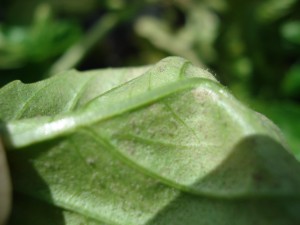by Kathryn Homa1,2, Robert Pyne1, Bill Barney2, Andy Wyenandt1, and Jim Simon1
Department of Plant Biology and Pathology, 1Rutgers University; 2IR-4 Program
Sweet basil (Ocimum basilicum) is an economically important fresh culinary herb grown in the United States. In fall of October 2007, a new disease of basil, downy mildew (Peronospora belbahrii) was first reported in FL. Since then, basil downy mildew has resulted in significant losses throughout the United States. The epidemiology of the pathogen is still unknown. However, it is believed that the pathogen has spread globally via the shipment of infested seed and through natural weather cycles. Unfortunately, there are currently no effective seed treatments for basil downy mildew.
The main diagnostic feature of the pathogen is the production of purplish gray sporangia that appear only on the abaxial (i.e., underside) surfaces of infected leaves (Fig 1). Symptoms include yellowing of foliage and eventual necrosis of leaf tissue (Fig 2). Once basil develops symptoms, plants are no longer marketable.

Fig 1. Basil downy mildew sporulating on
the underside of an infected leaf.
During the summers of 2010 -2012 at the Rutgers Agricultural Research and Extension Center (RAREC) in Bridgeton, NJ, conventional and biological fungicides were evaluated for efficacy in field trials.
In 2010 and 2011, 6 conventional and 7 biological fungicides were evaluated with nine weekly fungicide applications over the course of the growing season. Fungicide applications in 2010 and 2011 began before basil was infected with downy mildew. In 2010 and 2011, the systemic fungicide, K-Phite (phosphorous acid; FRAC Code 33) provided the best level of control.
In 2012, 7 conventional and 3 biological fungicides were evaluated with seven weekly fungicide applications over the course of the growing season. Fungicide applications in 2012 began after basil downy mildew was found in the trial. The fungicides K-Phite, Pro-Phyt (phosphorous acid, 33), Zampro (dimethomorph + ametoctradin, 40 + 45), Reason (fenamidone, 11) and tank mixes of Quadris (azoxystrobin, 11) + K-Phite or Pro-Phyt; or tank mixes of Ranman (cyazofamid, 21) + K-Phite alternated with combinations of Presidio (fluopicolide, 43) + K-Phite; or tank mixes of Ranman + Pro-Phyt alternated weekly with tank mix of Presidio + Pro-Phyt provided the best level of control. Of the products tested, the only registered products for control of basil downy mildew to-date are K-Phite, Pro-Phyt, Quadris and Ranman.
In each year of the study none of the organic fungicides tested provided an adequate level of season-long control.
Current recommendations for basil downy mildew disease control include using an integrated pest management (IPM) approach and a fungicide resistance management program. Growers should know the symptoms of basil downy mildew and monitor the field daily for detection of the pathogen.
If the pathogen is detected in the region, growers should make frequent protectant fungicide applications before the pathogen enters the field before symptoms appear.


